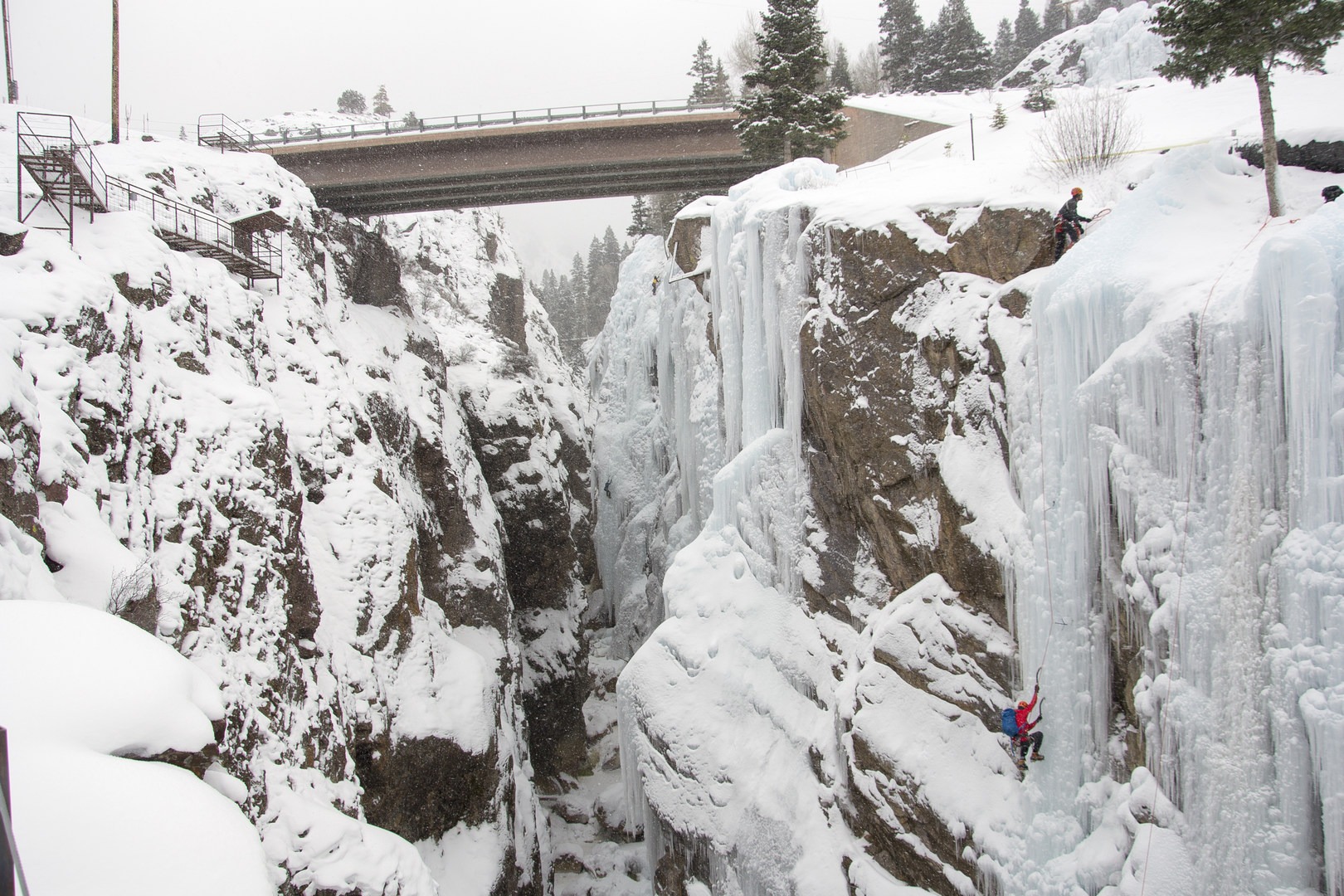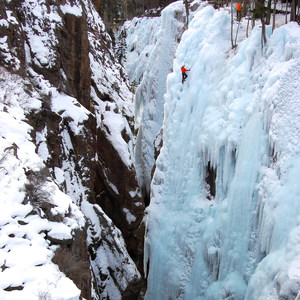You are here
The San Juan Mountains in Southwestern Colorado have a distinct landscape and dramatic topography that have been ingrained in my mind since I was a kid. Years ago during a summer road trip through Ouray I had picked up a paper brochure for San Juan Mountain Guides (SJMG), and the photos of people learning to ice climb at the Ouray Ice Park directed my daydreams to those of ice climbing.
The influence of that little tri-fold piece of paper proved to be the beginning of a new passion. For years it floated among my things, pressuring me to learn the art of ice climbing at the Ouray Ice Park. At some point the brochure disappeared, but a modern equivalent emerged. I eventually found SJMG on Instagram, and I tagged one of my photos from a 2013 climb of Handies Peak, a 14er in the San Juan Mountains, for one of their contests. While I didn’t win the grand prize, I did win some cool stickers, and I started tracking SJMG and Ouray Ice Park on Facebook.
Then the holidays and 2015 came into sight, and I knew I was going to be driving from Texas to Las Vegas around the new year. My girlfriend, Danielle, and I were looking for something brand new and incredible to start the year off, and I searched my mental map of the Southwestern U.S. on a daily basis looking for ideas. Both SJMG and Ouray Ice Park were posting images of the ice farmers prepping the park and grooming the ice, and then photos of the climbing itself. This was too much to see everyday, and I couldn't take the underlying pressure anymore! The timing was coming together, and while Ouray wasn’t directly on the way between Texas and Vegas, it was close enough for me. And hey, who’s counting?
I immediately thought about taking one of the SJMG private introductory ice-climbing courses because I had never done any technical Water Ice (WI) climbing. I checked with Danielle to see if ice climbing in Ouray was something she wanted to do, and she loved the idea. I knew we were going to be learning from some of the best guides in the San Juans, and I knew first hand what kind of impact a guiding service can make on your personal skills. Having first learned to rock climb with a guiding service in Texas as a kid, I later guided for that same company for six years. There is no more qualified knowledge that one can gain from a skilled local guide in any outdoor sports genre. Our plans were set, and off we went to our next adventure.
After the Christmas holiday, Danielle and I drove the long haul from Houston to Ouray, where we spent New Year's Eve eating at the Bon Ton Restaurant, watching fireworks on Main Street at midnight with the rest of town, and retiring to the peaceful St. Elmo Hotel. The next day we stopped by SJMG in the afternoon and met our guide, Jeff Dobronyi, who suggested we gear up so that we could hit the ice ready to climb the next morning. I loved our guide’s intention to hustle. Who wants to be the last one on the ice when you can be the first? I had my own mounaineering boots, a pair of LaSportiva Trango Evo GTX boots that are fully rigid and welted, but Danielle needed boots, and we both needed crampons and ice tools. SJMG, provided us with only the best ice climbing gear on the market, and it was already included in our course fee. After some brew and grub at the Ouray Brewery we called it a night so we would be ready for our ice-climbing course with SJMG the next morning.
We met our guide, Jeff, at 8:30 a.m. at SJMG and drove straight up to the Ice Park. We put our crampons and helmets on at the picnic tables below the Kids' Wall at the main entrance to the park and then took off along the top of the canyon toward our climbs. After a short hike Jeff set a top-rope anchor for our route and then hiked into the canyon to climb. We spent the first half-hour or more going over various climbing, footwork, and ice tool techniques. The “A-frame” technique proved to be a very valuable one: for this technique, you must first move your feet up to a side-by-side shoulder-width stance, then work your tools up one above the other, then repeat. From there we went straight into climbing a nice starter route rated Water Ice-2 (WI-2) with a ramp leading to a long section of varying ice “cauliflower” looking terrain. I tried my best to get my ice tool swing down with a “flick of the wrist,” letting the weight of the tool sink itself in. I quickly learned I could also get some very good tool placements by simply hooking holes and indentations on the ice.
Danielle had ice climbed in New Hampshire near Mount Washington before, but I had never done this. I had climbed plenty of rock, winter condition 14ers, and other small peaks, but no technical and vertical water ice routes. I found ice climbing to be physically easier than rock climbing, but I easily understood how dangerous leading on ice could be. I was used to falling rock being a big deal and trying to avoid it at all costs. With ice climbing, however, chunks of ice constantly fell. Most all of this ice was very small, though there were some fairly large pieces that caught my attention. Jeff and some other climbers explained that this falling ice was “normal,” so I shrugged it off, but I continued to keep a look out for the big chunks.
After climbing our first route we exited the canyon to setup another top-rope anchor and rappel in from the top. Once we rappelled into the canyon, our guide showed us how to build an anchor at the bottom. We learned how to place ice screws and how to “thread” ice with runners through a hole created by two adjacent ice screws. This is a good technique to build anchors so as to not leave any hardware behind when rappelling a route. While I knew I wasn't likely to start leading water ice routes anytime soon, I’m a gear-head, I love learning rigging and anchors skills, and this was very valuable information. This part of our course taught me just how strong ice is and how reliable an ice anchor can be, and it gave me a better understanding of the structural integrity of the ice.
We began taking turns climbing our second route after setting the anchors, and we planned to exit the canyon after topping out. This route proved to be a more challenging WI-4 that started with a slab of thin ice that led up to chossy and unstable vertical ice hidden under a solid row of overhanging cauliflowers. The trick was to make solid hooks with my tools while leaning all of my weight back and raising my feet. This route had enough sustained excitement to make me want to climb even harder. After we had all topped out, we called it a day since we had to head toward Moab that evening to stay on schedule. We made it back to SJMG on Main Street, unloaded our borrowed gear, said goodbye to our guide, and hit the road.
Our experience taking a private intro ice-climbing course with San Juan Mountain Guides was exactly what I had hoped for. We learned the fundamentals of ice climbing, had a look into lead anchors, and climbed a challenging route that made me want to ice climb more and climb harder. Ice climbing had plagued my mind for years, and I've now come full circle and started 2015 by ice climbing at Ouray Ice Park. Now more than ever, I am ready to seek out a more advanced ice climbing adventures, all thanks to that tri-fold SJMG brochure and a little hashtag.






Comments
Sign In and share them.